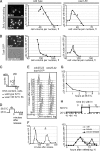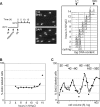Cyclin-dependent kinase inhibits reinitiation of a normal S-phase program during G2 in fission yeast
- PMID: 19487461
- PMCID: PMC2715816
- DOI: 10.1128/MCB.00185-09
Cyclin-dependent kinase inhibits reinitiation of a normal S-phase program during G2 in fission yeast
Abstract
To achieve faithful replication of the genome once in each cell cycle, reinitiation of S phase is prevented in G(2) and origins are restricted from refiring within S phase. We have investigated the block to rereplication during G(2) in fission yeast. The DNA synthesis that occurs when G(2)/M cyclin-dependent kinase (CDK) activity is depleted has been assumed to be repeated rounds of S phase without mitosis, but this has not been demonstrated to be the case. We show here that on G(2)/M CDK depletion in G(2), repeated S phases are induced, which are correlated with normal G(1)/S transcription and attainment of doublings in cell size. Mostly normal mitotic S-phase origins are utilized, although at different efficiencies, and replication is essentially equal across the genome. We conclude that CDK inhibits reinitiation of S phase during G(2), and if G(2)/M CDK is depleted, replication results from induction of a largely normal S-phase program with only small differences in origin usage and efficiency.
Figures





Similar articles
-
Control of S-phase periodic transcription in the fission yeast mitotic cycle.EMBO J. 1997 Aug 1;16(15):4676-88. doi: 10.1093/emboj/16.15.4676. EMBO J. 1997. PMID: 9303312 Free PMC article.
-
Rereplication phenomenon in fission yeast requires MCM proteins and other S phase genes.Genetics. 1999 Jul;152(3):839-51. doi: 10.1093/genetics/152.3.839. Genetics. 1999. PMID: 10388806 Free PMC article.
-
Tobacco BY-2 cells expressing fission yeast cdc25 bypass a G2/M block on the cell cycle.Plant J. 2005 Oct;44(2):290-9. doi: 10.1111/j.1365-313X.2005.02524.x. Plant J. 2005. PMID: 16212607
-
Down-regulation of Cdk1 activity in G1 coordinates the G1/S gene expression programme with genome replication.Curr Genet. 2019 Jun;65(3):685-690. doi: 10.1007/s00294-018-00926-y. Epub 2019 Jan 24. Curr Genet. 2019. PMID: 30680437 Review.
-
Cyclin-dependent kinases and S phase control in mammalian cells.Cell Cycle. 2003 Jul-Aug;2(4):316-24. Cell Cycle. 2003. PMID: 12851482 Review.
Cited by
-
Computational modeling of chromosome re-replication in mutant strains of fission yeast.Mol Biol Cell. 2021 Apr 19;32(9):830-841. doi: 10.1091/mbc.E20-09-0610. Epub 2021 Feb 3. Mol Biol Cell. 2021. PMID: 33534609 Free PMC article.
-
A visual atlas of meiotic protein dynamics in living fission yeast.Open Biol. 2021 Feb;11(2):200357. doi: 10.1098/rsob.200357. Epub 2021 Feb 24. Open Biol. 2021. PMID: 33622106 Free PMC article.
-
Checkpoint Regulation of Nuclear Tos4 Defines S Phase Arrest in Fission Yeast.G3 (Bethesda). 2020 Jan 7;10(1):255-266. doi: 10.1534/g3.119.400726. G3 (Bethesda). 2020. PMID: 31719112 Free PMC article.
-
Persistent telomere damage induces bypass of mitosis and tetraploidy.Cell. 2010 Apr 2;141(1):81-93. doi: 10.1016/j.cell.2010.01.031. Cell. 2010. PMID: 20371347 Free PMC article.
-
Active Replication Checkpoint Drives Genome Instability in Fission Yeast mcm4 Mutant.Mol Cell Biol. 2020 Jun 29;40(14):e00033-20. doi: 10.1128/MCB.00033-20. Print 2020 Jun 29. Mol Cell Biol. 2020. PMID: 32341083 Free PMC article.
References
-
- Arias, E. E., and J. C. Walter. 2007. Strength in numbers: preventing rereplication via multiple mechanisms in eukaryotic cells. Genes Dev. 21497-518. - PubMed
-
- Ayté, J., C. Schweitzer, P. Zarzov, P. Nurse, and J. A. DeCaprio. 2001. Feedback regulation of the MBF transcription factor by cyclin Cig2. Nat. Cell Biol. 31043-1050. - PubMed
-
- Bähler, J. 2005. Cell-cycle control of gene expression in budding and fission yeast. Annu. Rev. Genet. 3969-94. - PubMed
-
- Bähler, J., J.-Q. Wu, M. S. Longtine, N. G. Shah, A. McKenzie III, A. B. Steever, A. Wach, P. Philippsen, and J. R. Pringle. 1998. Heterologous modules for efficient and versatile PCR-based gene targeting in Schizosaccharomyces pombe. Yeast 14943-951. - PubMed
-
- Bates, S., K. M. Ryan, A. C. Phillips, and K. H. Vousden. 1998. Cell cycle arrest and DNA endoreduplication following p21Waf1/Cip1 expression. Oncogene 171691-1703. - PubMed
Publication types
MeSH terms
Substances
Grants and funding
LinkOut - more resources
Full Text Sources
Other Literature Sources
Molecular Biology Databases
